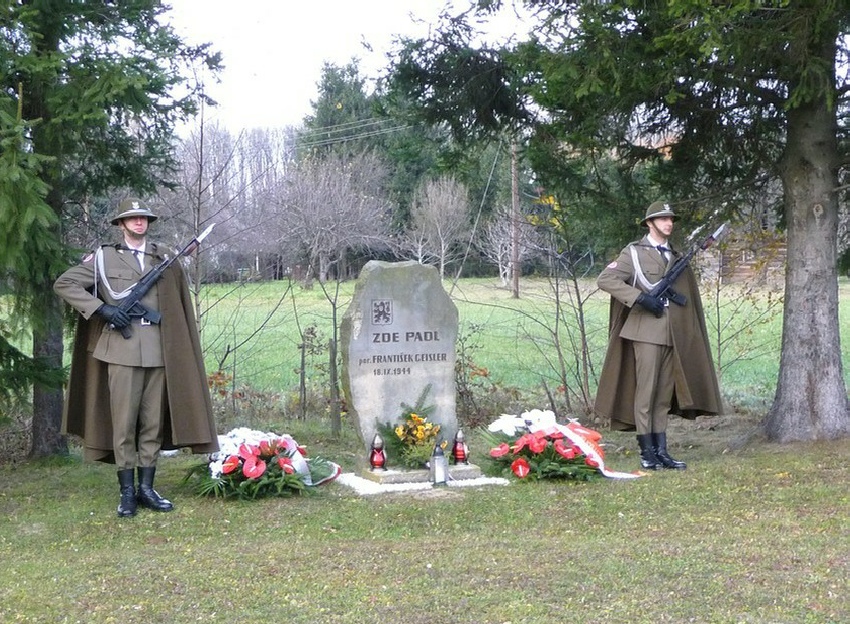
© FG Solutions 2019
Site last updated 24/08/2019

Through the "Valley of Death" and the Dukla Pass. Witold Szymczyk 1984 – an extract regarding the battle in Pastwiska and surrounding areas.
The 2nd Battalion of the 2nd Czechoslovak Parachute Brigade also entered the operation and took over its section of the front that day. Until September 15, the Brigade's troops carried out reconnaissance combat, stating that the opponent was still defending hard throughout the entire front. On September 15, when the 140th Infantry Division and the 4th Guard Armoured Corps fought near Rymanów, the 2nd Czechoslovak Parachute Brigade fought hard for Besko, liberated Milcza and Łazy, and the next day Besko. On September 16, the brigade reached the battle line -
That day, Marshal Koniev appeared in the Brigade command post. He informed Colonel Przikril about the planned operation of the armoured corps at the turn of Wisłok and the participation of paratroopers in this attack. He also stated that after completing this task, the brigade would be withdrawn from the front and moved by air to Slovakia, to assist in the Slovak Uprising. This announcement caused great enthusiasm among soldiers.
In the evening, the unit separated from the 4th Kantemir Armoured Corps and was ready for action. Its core was the 13th Guard Brigade of Colonel Leonid Baukov, reinforced with motorized rifles, sappers and tank guns. At night on September 17, the unit was to attack German positions in the Sieniawa area and advance south towards Pastwiska and Tarnawka. Behind them was the main forces of the Corps, and next to it, on the left, 31 Armoured Corps.
The night attack was successful. The surprised Germans could not withstand the onslaught and began to retreat trying to assemble the defence in the mountain gorge of the river Wisłok. In the morning, the 2nd Czechoslovak Parachute Brigade also advanced reaching the right wing along the eastern edge of Sieniawa to the northern part of the village of Pastwiska. Fierce fighting took place here, in which the commander of the Czechoslovakian unit fell, Lieutenant Geisler recently arrived from London.
Another group arrived at Głębokie and the 407 hill, where they encountered strong enemy resistance. The third group attacked from the Odrzechowa region the eastern edge of Sieniawa, and then attacked Pastwiska.
The 1st battalion advanced towards Wola Sękowa and Roztok, freeing Nadolana. In the evening they reached the line: Nowotaniec-
September 18 was a breakthrough day in the fighting south of Besko. Colonel Baukov's separate unit was successfully attacking. Tanks of the 31st Corps of Major General Vasyl Grigorjev went on to attack, and later also the main forces of the 4th Guard Armoured Corps of General Paweł Połuborajow. Czechoslovak paratroopers and Soviet army sappers of the 39th Army Brigade of Colonel B. Chaliziejew and the 42nd Engineering Front Brigade of Colonel J. Bondariev cooperated with the tanks. They also attacked the 67th Infantry Corps.
The 237th Armoured Brigade of Colonel W. Belousov from the 31st Corps hits the German resistance point in Pastwiska and, together with the separated unit of Colonel Baukowa, liberates this village.
The 2nd Battalion of the 13th Armoured Guards Brigade, under the command of Major Alexander Moroz (today an artist in Simferopol) set off from there to fight to capture the bridge on the Wisłok and thanks to the courage and even the risk of his armoured tankers, he managed to capture the crossing, losing several tanks.
On September 19, the 2nd Battalion of Czechoslovak paratroopers, as ordered, began to withdraw from the front line, implementing the decision to release the Brigade from the front and send it to Slovakia.
The commander of the 1st Battalion, after talking to the commander of the 242nd Armoured Brigade, decided to continue this day and help the tankers liberate Puławy. After strong artillery preparation, the paratroopers, as tank protection, struck along with the 242 Brigade on Puławy, captured the 689 hill (Polana) that dominated the area and by 21:00 they took the place itself. It wasn't until later, after warmly saying goodbye to the tank crews, the soldiers gathered to march to Jaćmierz, where the whole Brigade gathered. They did it without enthusiasm, they thought that it was so close to the border that it would be better to go south with the tankers and start liberating their Homeland sooner. Some groups, chasing after the enemy, not knowing the order to withdraw from the front did not return to the rear until the next day.
After leaving the front of the 2nd Czechoslovak Parachute Brigade, the 4th and 31st Armoured Corps continued their assault in terrain difficult for tanks. It was impossible to expand sub-